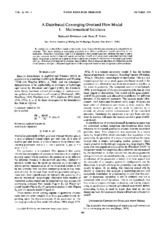| dc.creator | Sherman, Bernard | |
| dc.creator | Singh, Vijay P. | |
| dc.date.accessioned | 2011-03-30T17:05:50Z | |
| dc.date.available | 2011-03-30T17:05:50Z | |
| dc.date.issued | 1976-10 | |
| dc.identifier.citation | Sherman, B., and V. P. Singh (1976), A distributed converging overland flow model: 1. Mathematical solutions, Water Resources Research, 12(5), doi:10.1029/WR012i005p00889. To view the published open abstract, go to http://dx.doi.org and enter the DOI. | en |
| dc.identifier.issn | 0043-1397 | |
| dc.identifier.uri | http://dx.doi.org/10.1029/WR012i005p00889 | |
| dc.identifier.uri | https://hdl.handle.net/1969.1/94157 | |
| dc.description | An edited version of this paper was published by AGU. Copyright 1976 American Geophysical Union. | en |
| dc.description.abstract | In models for overland flow based on kinematic wave theory the friction parameter is assumed to be constant. This paper studies a converging geometry and allows continuous spatial variability in the parameter. Parameter variability results in a completely distributed approach, reduces the need to use a complex network model to simulate watershed surface runoff, and saves much computational time and effort. This paper is the first in a series of three. It develops analytical solutions for a converging geometry with no infiltration and temporally constant lateral inflow. Part 2 discusses the effect of infiltration on the runoff process, and part 3 discusses application of the proposed model to natural agricultural watersheds. | en |
| dc.language.iso | en | |
| dc.publisher | American Geophysical Union | |
| dc.title | A distributed converging overland flow model: 1. Mathematical solutions | en |
| dc.type | Article | en |
| local.department | Civil Engineering | en |
| local.department | Biological and Agricultural Engineering | en |


